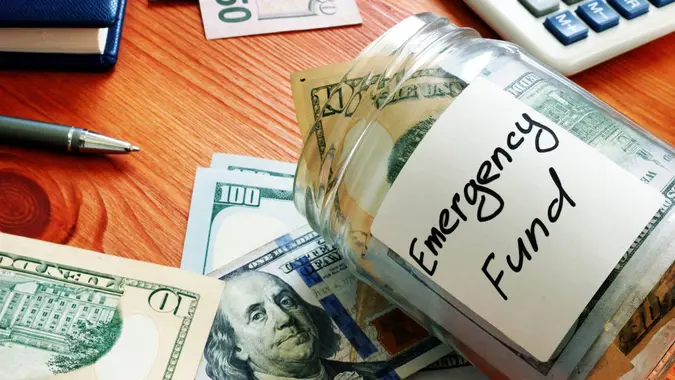The Emergency Savings Amount That Could Be the Key to Your Well-Being

Commitment to Our Readers
GOBankingRates' editorial team is committed to bringing you unbiased reviews and information. We use data-driven methodologies to evaluate financial products and services - our reviews and ratings are not influenced by advertisers. You can read more about our editorial guidelines and our products and services review methodology.

20 Years
Helping You Live Richer

Reviewed
by Experts

Trusted by
Millions of Readers
According to new findings from Vanguard, having emergency savings of at least $2,000 is linked to a 21% higher level of financial well-being.
Respondents with no emergency savings also reported having lower productivity due to more financial stress. Having a safety net has a number of benefits and can help to ensure stability and peace of mind.
Predictors of Financial Well-Being
Having emergency savings of at least $2,000 was associated with a 21% increase in financial well-being. As reported by Vanguard, having this emergency savings fund was one of the strongest predictors of financial well-being. Investors with three to six months of expenses saved, in addition to the $2,000 emergency fund, experienced a 13% higher level of financial well-being.
According to the Washington State Department of Financial Institutions, maintaining an emergency savings account for unexpected expenses, including car repairs and urgent medical services, can help individuals avoid taking on additional debt and minimize the disruption caused by unplanned expenses.
Lower Productivity and More Stress
Research by Vanguard showed that having no emergency savings was associated with lower productivity and more stress. Investors without an emergency fund spent nearly twice as many hours each week thinking and dealing with finances compared to people with savings of at least $2,000. Workers without the buffer were more distracted and less productive due to financial stress.
The Real Cost of Unexpected Expenses
Despite the importance of an emergency fund, many people feel that they would be unable to cover an unexpected expense of $400 or more. A study conducted by the AARP found that over 30% of respondents would be unable to afford an unplanned cost of that amount. Even individuals who have considerable income can still be living paycheck to paycheck and find themselves struggling with any surprise expenses.
Other Indicators of Financial Well-Being
While having an emergency savings fund of at least $2,000 was the strongest predictor of financial well-being, other factors, such as debt, income and the amount of assets, also played a role.
For instance, having a high income of $500,000 or more was associated with a 12% higher level of financial well-being, whereas having an income of $50,000 to $99,000 was only associated with a 5% increase.
Having debt, on the other hand, usually predicts a lower level of financial well-being. While having a substantial amount of assets ($1,000,000 or more) was connected to an 18% increase in financial well-being, it was nearly on par with having an emergency savings of $2,000. This indicates that individuals who are able to save even a small amount for unplanned expenses can have the same peace of mind as someone with far more financial assets.
Building an Emergency Fund
While building an emergency fund may seem overwhelming at first, a little can go a long way.
Experts at Fidelity recommend setting a goal of stashing at least $1,000 as quickly as possible. They suggest treating emergency savings as a monthly bill that must be paid every month and to consider making automatic contributions.
The emergency fund should be accessible and used for true emergencies instead of routine expenses. For people struggling to stash cash, it may require cutting costs, making the savings account a top priority.
More From GOBankingRates
 Written by
Written by  Edited by
Edited by 

























